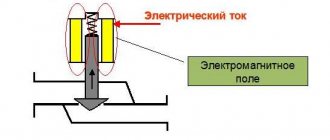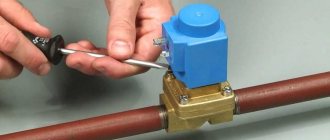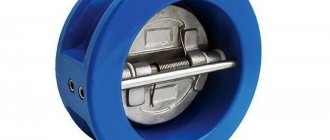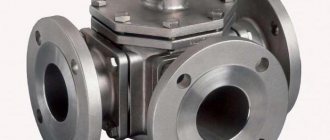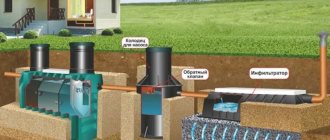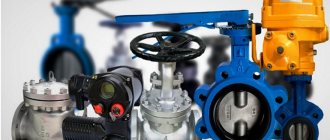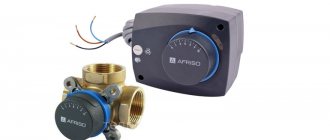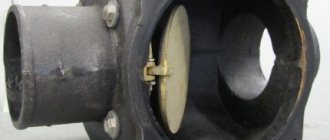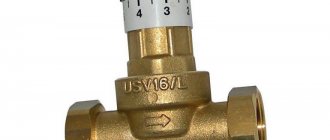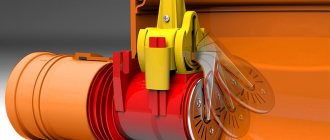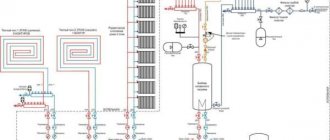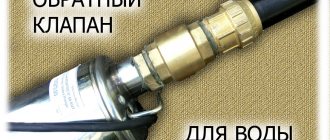When using water supply and heating systems, no one is immune from emergencies. An electromagnetic (solenoid) water valve allows you to minimize risks and losses in the event of a breakthrough. This device allows you to quickly shut off or, conversely, open the flow of water in a few seconds, while at a distance. Let us examine in detail how the solenoid valve is designed, its types, principles of operation and installation.
Design and principle of operation
A solenoid valve is a shut-off valve that closes the water flow and allows you to control the speed of fluid movement in the pipeline. These devices are called electromagnetic, since their operating principle is built around an electromagnetic coil (solenoid). There are several types of similar products and each has its own characteristics and differences in the principle of operation.
An automatic water valve includes the following components:
- frame;
- lid;
- membrane and seal;
- plunger;
- stock;
- electric coil.
The body of such units is usually made of materials such as brass, stainless steel (to increase resistance to corrosion) and cast iron. Plumbing solenoid valves made of plastic are quite popular.
Plungers and rods are made from materials that have magnetic properties. The electromagnetic coils are placed in a special protective housing, which has fairly high tightness parameters. The winding for the coils is usually made of copper wire or enameled wire. Such devices begin to work after voltage is applied to the coil.
An electromagnetic or in other words induction coil converts electricity into forward motion. The most common are coils with copper winding on a cylinder. The cylinder includes a magnetic plunger. As soon as a pulse is applied to the coil, a magnetic field appears. As a result of the magnetic field, the core is drawn into the coil.
Product membranes are made of polymer materials that have a high level of elasticity. Such materials include the following:
- membranes EPDM, NBR, FKM.
- PTFE or TEFLON seals.
Valves can be made from a variety of materials, with the body made from plastic, brass or cast iron.
If there is a need to shut off the supply of the transported medium, a pulse is sent from the control unit to the induction coil. Thanks to this signal, the core of the device rises or falls (it all depends on the configuration of the device) and blocks the flow of liquid. Immediately after the tension disappears, the core returns to its original position and fluid movement resumes.
Composition of solenoid valves
Structurally, the solenoid valve contains the following main elements:
- Housing and cover. Made from brass, polymers, cast iron, stainless steel - for conditions of various environments and temperatures.
- Seal parts, membranes. They are made from special types of rubber and fluoroplastic.
- Moving parts that are elements of the solenoid core. Made from materials with magnetic properties.
- The electric coil is made of copper enamel wire and sealed.
Benefits of using electromagnetic devices
The main advantage of a solenoid valve for water is that it allows you to quickly regulate the flow of the transported medium in the system. The device only needs 2-3 seconds to perform its functions. Because of this, the solenoid model is a fairly important device in the water supply systems of apartments and private houses.
It also makes it possible to regulate the temperature by regulating the flow of coolant. The electromagnetic device allows you to smoothly distribute the temperature in the heating system, thereby preventing its contamination. And this directly allows you to extend the service life of the entire heating system.
Due to the fact that the device in its design does not have wearable mechanical parts, solenoid models are more reliable. Such a device can be installed in systems with a wide variety of pressures, since this characteristic does not affect its operation.
It is because of these characteristics that electromagnetic models occupy a dominant position among shut-off valves on the market.
How to install an electric valve for water with your own hands (12 Volt, 220V)
You can handle installing a solenoid valve (12 Volt, 220V) on water yourself. To avoid mistakes during this process, it is advisable to adhere to some rules:
- It is not allowed to install a locking device equipped with a coil that can act as a lever;
- all work on installing or dismantling the valve can only be carried out after the system is completely de-energized;
- Care must be taken to ensure that the weight of the pipeline does not put pressure on the valve body.
Important! When installing an electric valve for water (12 Volt, 220V) with your own hands, you need to control the direction of the arrow on the device body. It should point in the same direction where the water moves through the pipeline.
Shut-off devices can be used in open areas, for example, at local wastewater treatment plants, which can often be found in summer cottages. In this case, the electromagnetic device needs additional protection. A standard FUM tape is suitable for these purposes. It must also be used if work is carried out at low temperatures.
Automatic watering with your own hands: how to install and use an irrigation system on your site
Selecting components. Automatic watering schemes. Sprinkling, drip irrigation and subsoil automated irrigation.
When connecting the device to the power supply, be sure to use a flexible cable. The recommended core cross-section is 1 mm.
When installing the device with your own hands, you need to control the direction of the arrow on the solenoid valve body
Solenoid valve installation process (220V, 12V): practical tips
Before proceeding with direct installation, you need to determine what type of connection will be used for this.
With a threaded connection, the outlet and inlet pipes have internal or external threads. By using fittings of the appropriate size and configuration, the fittings can be integrated into the pipeline system. This option is considered the most convenient if the valve is installed by yourself.
With a flange connection, pipes are used that have flanges at the ends. The same elements must be present on the pipes. The parts are tightened using bolts. The flange connection allows you to create a high flow rate in the system, as well as a considerable pressure. Most often it is found on highways with medium and high pressure.
Instructions with a detailed description of the installation process are included with each package containing the valve. If everything is done correctly, the device will work properly, providing protection against leaks. When installing the device, you need to leave a little extra space in the installation area. This is necessary so that, if necessary, the solenoid can be removed and replaced. In addition, the presence of free space will allow you to control the operation of the valve, using a mechanism that allows you to manually lift the rod.
Each solenoid valve is supplied with detailed instructions for installing the device.
It is advisable to install a filter at the inlet of the valve. It will trap solid particles larger than 800 microns. Only a normally closed valve should be installed in front of the expansion valve. To eliminate the possibility of water hammer when opening the shut-off device, as little space as possible should be left between it and the expansion valve.
Important! Installation of solenoid valves on water is carried out exclusively with the coil facing upwards.
It is not recommended to use adapters in the section before and after the valve. These elements can narrow the diameter of the pipeline, increasing the risk of water hammer. It is better to place adapters in front of the expansion valve. If you install a T-shaped tube vertically into the solenoid valve, which will act as a damper, you can reduce the force of the water hammer that occurs when closing. In addition, the presence of such a tube will increase the service life of the device. A damper is extremely necessary if the pipeline is long and has a small diameter.
Areas of application
An automatic water valve is a fairly useful device that is used in a wide variety of areas. This unit is successfully used in various sectors of the household and national economy, and also in various industrial sectors. Many air ducts and water pipes of varying degrees of design complexity successfully use this product in their work.
Equipment with a solenoid drive is most popular in designs where most of the devices operate on the principle of automatic control. The choice of application is mainly determined based on the material from which the valve is made. Similar devices can be found in washing machines, sewerage systems, irrigation systems, for controlling hydraulic systems, heating systems and many others.
He gained the greatest popularity in:
- Irrigation. Used for watering vegetable gardens, orchards, greenhouses. When installing such a device, all processes become automatic. An electromagnetic device with a servo drive (220, 24, 12 V), if a timer is connected to it, will allow you to set time intervals for operation and shutdown of the device. It can be in the normally open or closed position. Such rhythms will allow you to control the regulation of water flows. The advantages of using such a device are more than obvious - there is no need to waste time constantly monitoring the irrigation system.
- Sewers. The solenoid valve (12, 24 V) for water is quite widely used to regulate the water supply in public showers and toilets. It also uses a timer that allows you to automatically turn on and off the water pressure.
- Washing systems. The solenoid water valve (220, 24, 12 V) allows you to ensure timely drainage of water during car washing. Moreover, a similar device is used in household and industrial washing machines.
- Large scale kitchens. The supply solenoid valve sp6135 (220, 24, 12 V) is a truly integral device on conveyor systems for the production of bakery products, adjusting the water supply level to industrial dishwashers and coffee processors.
- Accurate dosing. The electromagnetic shutter for hot water plays an important role in the procedures for mixing various raw materials and materials.
- Heating systems. Water solenoid valve (220, 24.12 V) prevents interruptions in the operation of heating systems. The device allows you to make up for losses during the gradual evaporation of water on main heating routes.
In addition, electromagnetic models are used to regulate and control the transportation of various aggressive media in production. Devices used in production can be quite large in diameter. It is strictly forbidden to use brass models when working with aggressive substances, such as diesel fuel or acid.
Operational features of water valves
Provided that it is installed correctly, as well as if all requirements are met during operation, the solenoid valve can effectively serve for a long time, stabilizing the level of water pressure inside the pipeline. The solenoid allows you to extend the service life of pipes by evenly distributing loads.
If installed correctly, the solenoid valve will operate effectively for a very long time.
The main signs and causes of malfunctions of electric valves on water:
- Lack of power - most often occurs when the control panel cable is damaged.
- The valve does not work - if the spring fails, the device will not be able to function normally and respond to changes in voltage.
- The absence of a characteristic click when turned on can be caused by a burnt out solenoid.
The most common cause of valve failure is blockage. Therefore, if any malfunction occurs in the device, you should first check the hole where solid particles may accumulate.
Helpful advice! Experts recommend regularly checking the condition of the internal elements of the shut-off valve. This can only be done after the system is completely empty. If communications require complex repairs, it is better to hire professionals to do this work.
Types of automatic water valve
The solenoid valve (its types) are of two categories, the main difference of which is their operating principle of turning the mechanism on and off:
- direct action;
- pilot action.
In addition, they come in several main types, which have their own functional characteristics. Devices are:
- normally open (or normally closed). In the event that no voltage is applied to the coil, this device remains open (if it is normally open), and thus does not interfere with the flow. In the case of a normally closed valve, the opposite is true;
- bistable. As soon as voltage is supplied, the operating positions are switched.
Based on the type of coils, devices are divided into:
- direct current - the coil of devices of this type has a low electromagnetic field strength;
- alternating current - the coils of these devices have a fairly powerful electromagnetic field.
In addition, the units are divided by type of operation:
- one-way;
- two-way;
- three-way.
Single-pass ones have only one pipe and they cannot combine different flows of liquids. Two-way valves have two pipes (inlet and outlet). The operating principle of the one-way and two-way device operates on the method of functioning of the ball or cone, which is used for closing.
Three-way solenoid valves for water have as many as three pipes in their design and can operate based on mixing fluid flows. In addition, devices of this type can control and regulate temperature using mixing water flows. There are also explosion-proof models used when working with explosive environments. These valves are made of fire-resistant and durable materials. There are also vacuum valves.
Based on the type of connection to the pipeline, they are divided into:
- flanged valves;
- threaded valves.
Helpful information! There is a special type of device called a cut-off device. This type of device can instantly shut down a pipeline or clog one of the pipes during an accident.
Control and shut-off valves must be selected and installed only based on calculations made earlier. It is necessary to use one or another type of valve (normally closed, two-way, direct acting, etc.) depending on the type of pipeline and what type of medium is transported through it.
Classification of valves: what is a solenoid, main types of mechanisms
Solenoid valves are shut-off and control devices that are used to turn on and off a system within which a liquid or gas moves. They allow you to control the operation of communications remotely. These devices contain electric magnets called solenoids. This explains their name.
Solenoid valves are shut-off devices that are used to turn a system on and off
The solenoid valve has almost the same structure as the standard version of the locking device. The only difference is that the mechanism is activated when an electrical charge is applied to the solenoid valve coil. No physical effort is required to open and close it.
In industry, with the help of such valves, the process of transporting various media and liquids is controlled, and the current strength is also regulated. In addition, they are widely used in everyday life.
Solenoid solenoid valve: device classification
There are several types of solenoid locking devices. These devices are classified according to different criteria:
- type of construction;
- the material from which the body part is made;
- type of seal;
- the position of the lock inside when the system is de-energized;
- connection method.
Each type of device is designed to operate under different conditions, at a certain pressure and temperature. Devices of different types monitor their environment. There are water valves, gas valves, air valves, and steam valves. There are devices that regulate the operation of systems within which oil, gasoline and other types of fuel move.
The solenoid solenoid valve is classified by design type, connection method, lock position
Important! The solenoid valve must be selected very carefully. If you buy a device that doesn't meet the system's requirements, it won't last long.
According to the connection method, electromagnetic devices are coupling, flange and fitting. Their size varies between 6-150 DN, which allows you to select a locking mechanism for any pipeline. To make the body parts of devices, manufacturers use stainless steel, cast iron, brass, as well as various types of plastic that have an increased margin of safety.
The valve shuts off the liquid thanks to a membrane installed inside it. A sealant, which is made from elastic polymers, also takes part in this process:
- ethylene-propylene elastomer;
- fluoroelastomer;
- nitrile butadiene rubber.
According to the type of connection, solenoid valves are coupling, fitting and flange
Fluoroelastomer products can withstand high temperatures, as well as contact with gasoline and oils. Rubber seals have industrial applications because they are resistant to petroleum products. Electric water valves use ethylene propylene elastomer products. They can come into contact with acids, salts and alkalis that are present in the liquid.
Classification of electric valves for water according to their operating principle
The functionality of locking devices depends on the internal structure, the number of pipes and holes. Based on their operating principle, solenoid valves are divided into:
- to single-pass;
- two-way;
- three-way.
Single-pass products are connected to the pipeline system via one pipe. These devices perform a protective function. If the pressure level in the system increases, they simply release excess water or steam. 2/2 (2-way) solenoid valves have two ports, an inlet and an outlet.
Three-way devices are connected to pipes using three pipes. They have two inlets and redirect the media from one pipeline to another. Such devices are usually installed in heating systems. The functionality of solenoid solenoid valves (220V) with three pipes allows you to mix the working medium by distilling the coolant between two circuits. As a result, the temperature of the water in the system changes. At the same time, the pipeline continues to operate in the same mode.
Shutting off the movement of liquid is carried out using a membrane installed inside the valve
Note! The type of membrane must be selected taking into account the temperature of the working medium and its composition. Rust and sand present in pipes negatively affect the condition of these products, regardless of the material they are made of. Therefore, any type of valve is connected to the pipeline only if there is a filter.
According to the principle of operation, solenoid valves are either direct or indirect. In direct-acting devices, the core moves solely under the influence of an electromagnet. Indirect valves also react to the pressure of the working medium.
Tips for choosing
Valves are used in a wide variety of environments, which have their own individual temperature and pressure indicators. The choice of device type must be based on the characteristics of the environment, otherwise the device may not last long.
There are several key features to look for when choosing a solenoid valve. The main parameter is the diameter of the inlet and outlet openings.
The range of electromagnetic devices is quite large. They have various distinctive design features. But usually this does not greatly affect the operating parameters. The most popular are one-inch electromagnetic devices, whose flow rate reaches 40 l/min.
Important! Before purchasing a valve, special attention must be paid to the mechanical regulator built into the device. It may have several modes. The greater their number, the better the system will be controlled.
In cases where a valve with the highest possible throughput is required, the SVR series device can be purchased. In a normally closed position, the valve of this series can have fluid flow rates of up to 100 l/min. Valve prices vary according to their quality characteristics.
Selecting a solenoid valve: device prices and popular brands
When selecting shut-off valves for a water supply system, you must carefully study the specifications and descriptions provided by the manufacturer. This information will allow you to determine under what conditions the installation of a particular valve model is permissible.
When choosing a valve for a water supply system, you need to pay attention to the dimensions of the outlet and inlet holes.
When choosing a device, you need to take into account the following points:
- system type;
- temperature regime;
- pressure level;
- chemical composition of the liquid;
- current speed, etc.
The dimensions of the outlet and inlet openings are of considerable importance. These parameters must correspond to the diameter of the pipes. It is very important that the characteristics of the system and shut-off valves match, otherwise disruptions in the hydraulics of communications may occur. This outcome is possible if, in the area where the valve is installed, the flow of liquid slows down due to a narrow hole, which will inevitably affect the pressure level and temperature in the entire pipeline.
Solenoid valve prices:
| Device model | Price, rub./piece |
| Ceme Solenoid Valves | |
| D20 G3/4 | 3200 |
| D25 G1″ | 4750 |
| 87 G 2 1/2 D65 | 33200 |
| 87 G 3 D75 | 38650 |
| D75 G 3 D75 | 46850 |
| Shut-off solenoid valves ZSK | |
| ZSK-15 DU 15 | 12500 |
| ZSK-25 DU 25 | 13200 |
| ZSK-32 DU 32 | 14000 |
| Danfoss solenoid valves | |
| EV210B solenoid valves | |
| EV210B G 3/8 NC | 2850 |
| EV210B DN8 G 3/8 NC | 3350 |
| EV210B G 1/4 | 4200 |
| EV210B | 4850 |
| EV220B solenoid valves | |
| EV 220B 6B | 2800 |
| EV220B NC G1/2 | 5500 |
| EV220B NO G1/2 | 6450 |
| EV220B 20B | 11150 |
| EV220B 32B | 16550 |
Danfoss solenoid valves
Danfoss valves are equipped with various types of equipment - from pumps installed at gas stations, to machines that can be found in dry cleaners. The small size of these devices does not at all affect their level of reliability. Danfoss produces a wide range of valves. Thanks to this, in stores you can find modifications that other manufacturers produce exclusively on special order.
Danfoss solenoid valves are small in size, but this does not affect their level of reliability at all
Advantages of Danfoss solenoid valves:
- a wide range of general purpose devices;
- even standard modifications can solve many problems faced by the industry;
- The product range allows you to select devices that can come into contact with very aggressive media, for example, valves whose body is made of stainless steel and is provided with protection class IP67.
Note! If necessary, Danfoss may modify products based on the buyer's specifications. Thanks to this, you can find optimal solutions for any industrial task. Moreover, representatives of the purchasing company can take part in the development process.
The shut-off devices come with a complete technical documentation package and also provide simplified guides to help customers select the valve with the right characteristics. The production process involves specialists who are experts in the regulation of gas, steam and liquids. Therefore, the products are characterized by high functionality, reliability and safety.
Danfoss produces both direct-acting and servo-operated solenoid valves
On sale you can find direct acting electromagnetic locking devices equipped with a servo drive. Danfoss EV220B two-way solenoid valves, which are designed to regulate neutral gases, water, air, and oils, are in particular demand. Some modifications from this line can control steam and mildly aggressive environments.
Features of Asco solenoid valves
The American company Asco is one of the leading manufacturers of hydropneumatic, electromagnetic and shut-off valves, as well as pneumatic cylinders, pneumatic automation and other automation devices.
Product advantages:
- instrumentation equipment is manufactured on modern production lines with a wide range of functionality;
- if necessary, the valves can be easily repaired, and the process itself does not take much time;
- high level of reliability;
- ability to withstand contact with aggressive environments and extreme loads.
The manufacturer produces more than 5,000 standard types of shut-off valves. In addition, Asco produces special modifications and versions of these devices, the number of which exceeds 20,000. All of them are designed to meet the different needs of customers. At the same time, the manufacturer complies with the strictest quality requirements, monitoring all stages of production, including the development process, sales, and service.
The quality of Asco solenoid valves is confirmed by ISO 9002 and 9001 certificates
Note! Before hitting store shelves, products are carefully checked for manufacturing defects and are also tested. The highest quality of the valves is confirmed by ISO 9002 and 9001 certificates.
Arcom Products: AR HX 3 Solenoid Valve Specifications
Arcom supplies the market with thousands of items of electrical equipment. This list includes recorders (paperless and paper), controllers, electrical and measuring instruments, various tools and related accessories. Solenoid valves occupy a special place in the range. Buyers can purchase more than 4,500 locking device options at an affordable price. Moreover, all products are certified and meet a high level of quality.
In the manufacturer's catalogs you can select fittings that allow you to control the movement of water, air and petroleum products. In addition, the manufacturer provides a huge selection of spare parts, relays, coils, connectors and valves for these devices.
Despite the extensive range, special attention is paid to solenoid valves; the HX 3 solenoid valve, due to its many advantages, is considered the most popular model:
Solenoid valve AR HX 3 is designed to regulate steam, air, hot and cold water
- durable, durable stainless steel case;
- fast response (reacts when the pressure reaches zero);
- minimum sizes;
- ability to connect to sensors.
This model is designed to regulate hot and cold water, steam and air, which allows you to install the valve even in electric irons, coffee machines and other devices that use steam in their work.
General characteristics of Tork solenoid valves
The valves manufactured under the Tork brand name are manufactured by SMS. The high quality of products is appreciated by many countries in Asia, America and Europe, so about 40% of goods are exported. The production process is fully automated. In the manufacture of valves, virtually no manual labor is used, which eliminates the possibility of defects caused by the human factor.
The company's product range includes the following types of valves:
When manufacturing Tork valves, the possibility of defects is eliminated, since manual labor is not used in production
- bistable and monostable;
- for gases and liquids that have aggressive and neutral effects;
- for water and steam at elevated temperatures;
- for light petroleum products and gasoline;
- for vacuum;
- for piston compressors, etc.
Before going on sale, the fittings are examined for leaks, and the strength characteristics of the body are tested (for this, the product is exposed to five times the pressure). Using a non-contact tester, the functionality of the solenoid coils is checked.
All of the listed companies involved in the production of solenoid valves produce products of the highest quality. Thanks to these devices, the process of operating equipment and communication systems becomes completely controlled and safe. The service life of the valve and its efficiency will depend on how correctly the valve model is selected, as well as on its characteristics.
Operating principle of electromagnetic systems
The electromagnetic inductor operates in all known AC and DC voltages (220V AC, 24 AC, 24 DC, 5 DC, etc.). The solenoids are placed in special housings protected from water. Due to the low energy consumption, especially for small electromagnetic systems, control using semiconductor circuits is possible.
The smaller the air gap between the stopper and the electromagnetic core, the more the magnetic field strength increases, regardless of the type and magnitude of the applied voltage. Electromagnetic systems with alternating current have a much larger rod size and magnetic field strength than systems with direct current.
When voltage is applied and the air gap is at its maximum extent, the AC system, consuming a large amount of energy, raises the rod and the gap closes. This increases the power of the output flow and creates a pressure drop. If direct current is supplied, then the increase in flow rate occurs rather slowly until the voltage value becomes fixed. For this reason, the valves can only regulate low pressure systems, except those equipped with small bores.
In other words, in a static position, provided that the coil is de-energized and the device is in the closed/open position (depending on the type), the piston is in a tight connection with the valve seat. When voltage is applied, the coil transmits an impulse to the actuator and the rod opens. This is possible because the coil generates a magnetic field, which in turn acts on the plunger and is drawn into it.
